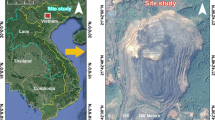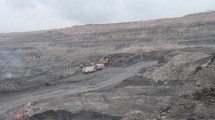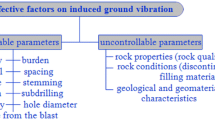Abstract
Blasting operation is widely used method for rock excavation in mining and civil works. Ground vibration and air-overpressure (AOp) are two of the most detrimental effects induced by blasting. So, evaluation and prediction of ground vibration and AOp are essential. This paper presents a new combination of artificial neural network (ANN) and K-nearest neighbors (KNN) models to predict blast-induced ground vibration and AOp. Here, this combination is abbreviated using ANN-KNN. To indicate performance of the ANN-KNN model in predicting ground vibration and AOp, a pre-developed ANN as well as two empirical equations, presented by United States Bureau of Mines (USBM), were developed. To construct the mentioned models, maximum charge per delay (MC) and distance between blast face and monitoring station (D) were set as input parameters, whereas AOp and peak particle velocity (PPV), as a vibration index, were considered as output parameters. A database consisting of 75 datasets, obtained from the Shur river dam, Iran, was utilized to develop the mentioned models. In terms of using three performance indices, namely coefficient correlation (R 2), root mean square error and variance account for, the superiority of the ANN-KNN model was proved in comparison with the ANN and USBM equations.
















Similar content being viewed by others
References
Hustrulid W (1999) Blasting principles for open pit mining: general design concepts. Balkema, Rotterdam
Jahed Armaghani D, Hajihassani M, Sohaei H, Mohamad ET, Marto A, Motaghedi H, Moghaddam MR (2015) Neuro-fuzzy technique to predict air-overpressure induced by blasting. Arab J Geosci. doi:10.1007/s12517-015-1984-3
Hasanipanah M, Monjezi M, Shahnazar A, Jahed Armaghani D, Farazmand A (2015) Feasibility of indirect determination of blast induced ground vibration based on support vector machine. Measurement 75:289–297
Ghasemi E, Ataei M, Hashemolhosseini H (2012) Development of a fuzzy model for predicting ground vibration caused by rock blasting in surface mining. J Vib Control 19:755–770
Monjezi M, Hasanipanah M, Khandelwal M (2013) Evaluation and prediction of blast-induced ground vibration at Shur River Dam, Iran, by artificial neural network. Neural Comput Appl 22:1637–1643
Trivedi R, Singh TN, Raina AK (2014) Prediction of blast-induced flyrock in Indian limestone mines using neural networks. J Rock Mech Geotech Eng 6:447–454
Khandelwal M, Singh TN (2007) Evaluation of blast-induced ground vibration predictors. Soil Dyn Earthq Eng 27:116–125
Khandelwal M, Singh TN (2009) Prediction of blast-induced ground vibration using artificial neural network. Int J Rock Mech Min Sci 46:1214–1222
Trivedi R, Singh TN, Gupta NI (2015) Prediction of blast-induced flyrock in opencast mines using ANN and ANFIS. Geotech Geol Eng 33:875–891
Singh TN, Dontha LK, Bhardwaj V (2008) Study into blast vibration and frequency using ANFIS and MVRA. Min Technol 117(3):116–121
Khandelwal M, Singh TN (2013) Application of an expert system to predict maximum explosive charge used per delay in surface mining. Rock Mech Rock Eng 46(6):1551–1558
Khandelwal M, Kankar PK (2011) Prediction of blast-induced air overpressure using support vector machine. Arab J Geosci 4:427–433
Bhandari S (1997) Engineering rock blasting operations. A.A. Balkema, Netherlands
ISRM (1992) Suggested method for blast vibration monitoring. Int J Rock Mech Min Geomech Abstr 29:145–156
Singh TN, Singh A, Singh CS (1994) Prediction of ground vibration induced by blasting. Indian Min Eng J 31–34:16
Rai R, Singh TN (2004) A new predictor for ground vibration prediction and its comparison with other predictors. Indian Journal of Engineering and Materials Sciences 11:178–184
Verma AK, Singh TN (2013) Comparative study of cognitive systems for ground vibration measurements. Neural Comput Appl 22:341–350
Duvall WI, Fogleson DE (1962) Review of criteria for estimating damage to residences from blasting vibration. USBM-RI, 5968
Mohamed MT (2011) Performance of fuzzy logic and artificial neural network in prediction of ground and air vibrations. Int J Rock Mech Min Sci 48:845–851
Ghasemi E, Kalhori H, Bagherpour R (2016) A new hybrid ANFIS–PSO model for prediction of peak particle velocity due to bench blasting. Eng Comput. doi:10.1007/s00366-016-0438-121
Hajihassani M, Jahed Armaghani D, Monjezi M, Mohamad ET, Marto A (2015) Blast-induced air and ground vibration prediction: a particle swarm optimization-based artificial neural network approach. Environ Earth Sci. doi:10.1007/s12665-015-4274-1
Hajihassani M, Jahed Armaghani D, Sohaei H, Tonnizam Mohamad E, Marto A (2014) Prediction of airblast-overpressure induced by blasting using a hybrid artificial neural network and particle swarm optimization. Appl Acoust 80:57–67
Jahed Armaghani D, Hasanipanah M, Mohamad ET (2015) A combination of the ICA-ANN model to predict air- overpressure resulting from blasting. Eng Comput. doi:10.1007/s00366-015-0408-z
Hasanipanah M, Jahed Armaghani D, Khamesi H, Bakhshandeh Amnieh H, Ghoraba S (2015) Several non-linear models in estimating air-overpressure resulting from mine blasting. Eng Comput. doi:10.1007/s00366-015-0425-y
Saadat M, Khandelwal M, Monjezi M (2014) An ANN-based approach to predict blast-induced ground vibration of Gol-E-Gohar iron ore mine, Iran. J Rock Mech Geotech Eng 6:67–76
Mohamadnejad M, Gholami R, Ataei M (2012) Comparison of intelligence science techniques and empirical methods for prediction of blasting vibrations. Tunn Undergr Space Technol 28:238–244
Jahed Armaghani D, Hajihassani M, Mohamad ET, Marto A, Noorani SA (2013) Blasting-induced flyrock and ground vibration prediction through an expert artificial neural network based on particle swarm optimization. Arab J Geosci. doi:10.1007/s12517-013-1174-0
Swingler K (1996) Applying neural networks: a practical guide. Academic Press, New York
SPSS Inc (2007) SPSS for Windows (Version 16.0). SPSS Inc, Chicago
Fausett LV (1994) Fundamentals of neural networks: architecture, algorithms and applications. Prentice-Hall, Englewood Cliffs
Dreyfus G (2005) Neural networks: methodology and application, 2nd edn. Springer, Berlin, Heidelberg
Monjezi M, Bahrami A, Yazdian Varjani A (2010) Simultaneous prediction of fragmentation and flyrock in blasting operation using artificial neural networks. Int J Rock Mech Min Sci 47:476–480
Hecht-Nielsen R (1987) Kolmogorov’s mapping neural network existence theorem. In: Proceedings of the first IEEE international conference on neural networks, San Diego, CA, USA, pp 11–14
Ripley BD (1993) Statistical aspects of neural networks. In: Barndoff-Neilsen OE, Jensen JL, Kendall WS (eds) Networks and chaos-statistical and probabilistic aspects. Chapman & Hall, London, pp 40–123
Wang C (1994) A theory of generalization in learning machines with neural application. Ph.D. thesis, The University of Pennsylvania, USA
Masters T (1994) Practical neural network recipes in C++. Academic Press, Boston MA
Kaastra I, Boyd M (1996) Designing a neural network for forecasting financial and economic time series. Neurocomputing 10:215–236
Zorlu K, Gokceoglu C, Ocakoglu F, Nefeslioglu HA, Acikalin S (2008) Prediction of uniaxial compressive strength of sandstones using petrography-based models. Eng Geol 96(3):141–158
Hush DR (1989) Classification with neural networks: a performance analysis. In: Proceedings of the IEEE international conference on systems engineering, Dayton, pp 277–80
Simpson PK (1990) Artificial neural system: foundation, paradigms, applications and implementations. Pergamon, New York
Demuth H, Beale M, Hagan M (2009) Neural network toolbox: user’s guide. Mathworks, MA
Tiryaki B (2009) Estimating rock cuttability using regression trees and artificial neural networks. Rock Mech Rock Eng 42:939–946
Marto A, Hajihassani M, Jahed Armaghani D, Tonnizam Mohamad E, Makhtar AM (2014) A novel approach for blast-induced flyrock prediction based on imperialist competitive algorithm and artificial neural network. Sci World J. doi:10.1155/2014/643715
Dressler F (2007) Self-organization in sensor and actor networks, 1st edn. Wiley, New York
Halkidi M, Batistakis Y, Vazirgiannis M (2001) On clustering validation techniques. J Intell Inf Syst 17:107–145
Kononenko I, Kukar M (2007) Machine learning and data mining, 1st edn. Woodhead Publishing, Cambridge
Bora DJ, Gupta AK (2014) Effect of different distance measures on the performance of K-means algorithm: an experimental study in Matlab. Int J Comput Sci Inf Technol 5(2):2501–2506
Duda RO, Stork DG, Hart PE (2000) Pattern classification, 2nd edn. Wiley, New York
Xu R, Wunsch D (2008) Clustering. Wiley-IEEE Press, New York
Yegnanarayana B (1994) Artificial neural networks for pattern recognition. Sadhana 19(2):189–238
Eyupoglu V, Eren B, Dogan E (2010) Prediction of ionic Cr(VI) extraction efficiency in flat sheet supported liquid membrane using artificial neural networks (ANNs). Int J Environ Res 4(3):463–470
Bengio Y et al (1992) Global optimization of a neural network-hidden markov model hybrid. IEEE Trans Neural Netw 3(2):252–259
Yin C, Rosendahl L, Luo Z (2003) Methods to improve prediction performance of ANN models. Simul Model Pract Theory 11:211–222
Zhenhuan G, Xiaohui G, Wilkes J (2010) PRESS: PRedictive Elastic ReSource Scaling for cloud systems. In: International conference on network and service management (CNSM)
Author information
Authors and Affiliations
Corresponding author
Rights and permissions
About this article
Cite this article
Amiri, M., Bakhshandeh Amnieh, H., Hasanipanah, M. et al. A new combination of artificial neural network and K-nearest neighbors models to predict blast-induced ground vibration and air-overpressure. Engineering with Computers 32, 631–644 (2016). https://doi.org/10.1007/s00366-016-0442-5
Received:
Accepted:
Published:
Issue Date:
DOI: https://doi.org/10.1007/s00366-016-0442-5




